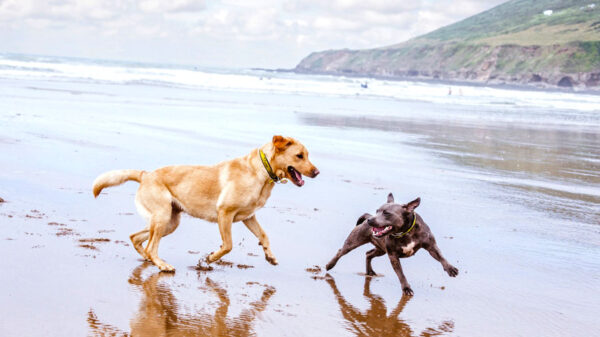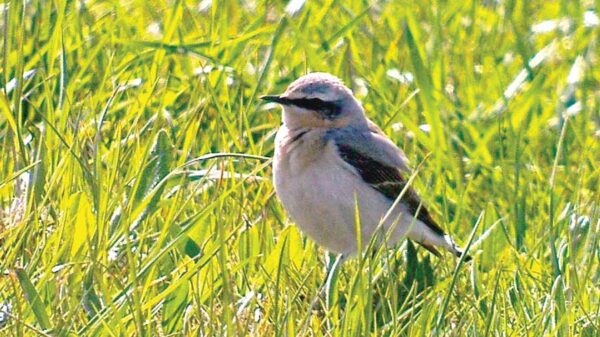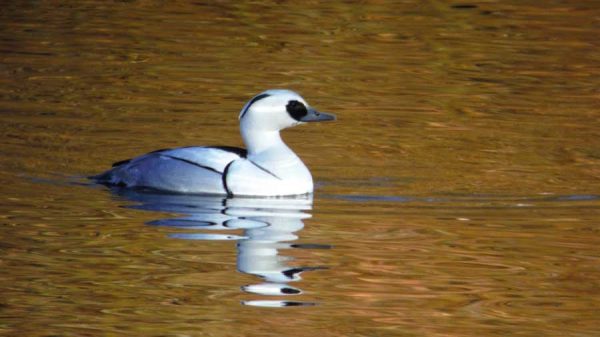−−− BY LINDA JENKINSON −−−
The dipper is probably the first bird that every wildlife watcher hopes to find when walking along a river or upland stream in the Yorkshire Dales. However, despite their striking white breasts, dippers can easily be overlooked. The fact that they blend into their environment so well is probably due to their bobbing behaviour. This helps to camouflage them within their surrounding white, rippling water as it tumbles over rocks and stones. As well as its white breast, which probably serves to break the outline of this bird in the tumbling water, the dipper’s eyelid is also covered by white feathers which creates a white flash when the bird is blinking. Dippers spend a great deal of time underwater, searching for invertebrates such as stonefly and caddis fly larvae. In fact, the dipper is the only diving passerine species (passerines are perching birds – from larks to buntings in your bird book).
As you can imagine, it can’t be easy to find food under rocks in rushing water, against the flow, but the dipper specialises in this habitat. To do this, dippers have developed some unique adaptations. Completely different to other flying birds which have honeycombed bones, dippers have a solid skeleton making them heavier in water. Their short, stout wings have strong muscles which allows them to swim under water and they have well developed muscles on their legs, and sharp claws, to allow them to walk along the riverbed. Because it’s a passerine, the dipper doesn’t have webbed feet unlike all other diving birds.
As a dipper dives, its dense plumage is covered by a film of trapped air. This is made possible by a specially adapted preen gland which produces extra oil to waterproof its feathers. This trapped air probably protects the dipper’s feathers while swimming in fast-flowing water and replaces some of the buoyancy lost due to the density of its bones. The air helps the dipper to return rapidly to the surface once it lets go of the underwater rocks and the oil content of their plumage eliminates the necessity for them to stand and dry their feathers.
The amazing range of adaptations doesn’t end there. Their ocular muscles have also evolved to enable them to change the curvature of the lens of the eye to enable them to see well under running water. This adaptation is shared with other diving species such as ducks, cormorants and gannets but the dipper’s adaptation is the most highly developed of passerines. To prevent the dipper from drowning by having water forced into their nostrils during a dive, a nasal flap closes as they submerge. They also have specially adapted blood to allow them to dive for over 30 seconds. They have more haemoglobin than other birds allowing them to store more oxygen in the blood cells. They also have a slower metabolic rate for their size and are able to reduce their heartbeat during dives to save oxygen.
February is the start of the breeding season for dippers and it’s possible to see them nest building and singing close-by. The sound of their sweet, warbling notes is most noticeable during the relatively song-less winter days. Both sexes sing and call. Their 300m to 3km linear territory is fiercely defended and, during disputes, there is an increase in bobbing and winking of white eyelids. Their nest is a large domed structure constructed of moss and lined with leaves, built under bridges, culverts, under waterfalls or beneath tree roots. They take to man-made nests constructed of pipes placed under bridges. Thankfully, urban waterways are now clean enough to support dippers in the city. Leeds is home to a growing number of dipper nests and they can be seen regularly on the River Aire and adjoining woodland streams.
Linda Jenkinson teaches people about birds in and around Leeds. For details of classes email linda@startbirding.co.uk or call 07778 768719. Visit www.startbirding.co.uk or Start Birding on Facebook and Twitter







